Understanding Inditex: The Fashion Retail Giant

Introduction
Inditex, the world’s largest apparel retailer, has been at the forefront of the fashion industry for decades. Known for its unique business model that promotes quick turnaround from design to store, Inditex operates several well-known brands including Zara, Massimo Dutti, and Pull&Bear. As of 2023, the company’s significant influence on fashion, sustainability efforts, and adaptation to changing consumer behaviours highlight its importance in the retail sector.
Overview of Inditex’s Operations
Founded in 1985 in Spain by Amancio Ortega and Rosalía Mera, Inditex has rapidly expanded its reach with over 7,000 stores across more than 90 countries. The company’s flagship brand, Zara, is particularly noted for its ability to introduce new fashion trends at a swift pace, often referred to as ‘fast fashion’. Inditex’s strategy includes a vertically integrated logistics system, allowing for flexible production and inventory management.
Recent Developments
In recent months, Inditex has been making headlines for its commitment to sustainability. The company has set ambitious goals to reduce its carbon footprint and increase the use of sustainable materials in its products by 2025. In its latest annual report, Inditex confirmed that 50% of its cotton and linen is organic or recycled, demonstrating a shift towards more environmentally responsible fashion. This initiative is a direct response to growing consumer demand for sustainable practices in the fashion industry.
Furthermore, Inditex has embraced digital transformation, enhancing its online platforms to cater to a global customer base. The pandemic accelerated the shift towards online shopping, and Inditex reported a significant increase in e-commerce sales, contributing to overall growth even amidst challenging retail conditions.
Challenges and Future Outlook
Despite its success, Inditex faces challenges, including rising raw material costs and shifts in consumer preferences post-pandemic. Analysts suggest that the company’s ability to adapt to these changes will be crucial for its continued leadership in the industry. As market competition increases, particularly from online retailers and niche brands, Inditex’s focus on innovation and sustainability will play a pivotal role in maintaining its position.
Conclusion
Inditex represents not just a major player in the global fashion scene, but also a case study in adapting to market dynamics and consumer consciousness regarding sustainability. As it continues to evolve, the company stands as a significant benchmark for retail practices worldwide. Future strategies focusing on sustainability and innovation may define Inditex’s path for decades to come, making it essential for industry stakeholders and consumers alike to stay informed on its developments.









